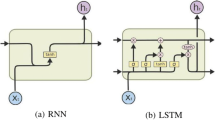Abstract
This work illustrates the use of neural networks for system identification of the dynamics of a distributed parameter system, an adsorption column for waste-water treatment of water containing toxic chemicals. System identification of this process is done from simulated data for this work. The inputs to the networks include the state of the column at a given point in time and the system input, the velocity. The network predicts the change in the state over a period of time based on these inputs. Recurrent networks were found to be capable of simulating the whole operation of the column from an initial state of zero concentrations throughout the column, and thus predicting the complete breakthrough curves. The feasibility of system identification of this process has been established using synthetic noisy data, which indicates that the same can be performed from experimental data when all the required measurements are available.
Similar content being viewed by others
References
Bulsari A, Saxén H. System identification of a biochemical process using feed-forward neural networks. Neurocomputing 1991; 3: 125–133
Bulsari A, Medvedev A, Saxén H. An algorithm for sensor fault detection using state vector estimator and feed-forward neural networks applied to a biochemical process. Acta Polytechnica Scandinavica, Chemical Technology and Metallurgy series No. 199, 1991, 1–20
Bulsari A, Saxén H. Estimation of state and disturbance in a biochemical process using feed-forward neural networks. Report 33, Chemical Technology, Lappeenranta University of Technology, May 1992
Bulsari A, Saxén H. Filtering, smoothing and prediction in a biochemical process using feed-forward neural networks. Report 92-4, Värmeteknik, Åbo Akademi, July 1992
Bulsari A, Saxén B, Saxén H. Control of a fedbatch bioreactor using feed-forward neural networks. Report 92-7, Värmeteknik, Åbo Akademi, August 1992
Bulsari A, Saxén H. A study on multivariable control using feed-forward neural networks. Report 92-5, Värmeteknik, Åbo Akademi, July 1992
Suzuki M. Adsorption Engineering: Chemical Engineering Monographs, Vol 25. Amsterdam: Elsevier, 1990
Fletcher R. Practical Methods of Optimization: Vol 1, Unconstrained optimization. Chichester: Wiley, 1980, 82–88
Gill PE, Murray W, Wright MH. Practical Optimization. London: Academic Press, 1981, 136–140
Levenberg K. A method for the solution of certain nonlinear problems in least squares. Quart Appl Math 1944; 2: 164–168
Marquardt DW. An algorithm for least-squares estimation of nonlinear parameters. J Soc Ind Appl Math June 1963; 11: 431–441
Jones WP, Hoskins J. Back-Propagation: A generalized delta learning rule. Byte, October 1987, 155–162
Bulsari A, Saxén B, Saxén H. Programmen ANNAT och EVAL för framåtkopplade neurala nätverk. Report 91-2, Värmeteknik, Åbo Akademi, April 1991
Reunanen J. Calculation of the Breakthrough Curve of Adsorption Column (in Finnish). Licentiate of Technology Thesis, Lappeenranta University of Technology, Finland, 1992
Author information
Authors and Affiliations
Rights and permissions
About this article
Cite this article
Bulsari, A.B., Palosaari, S. Application of neural networks for system identification of an adsorption column. Neural Comput & Applic 1, 160–165 (1993). https://doi.org/10.1007/BF01414435
Received:
Issue Date:
DOI: https://doi.org/10.1007/BF01414435




